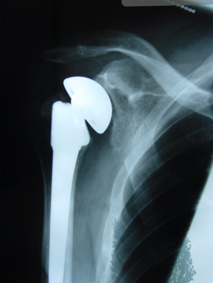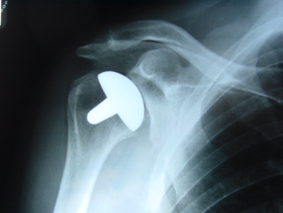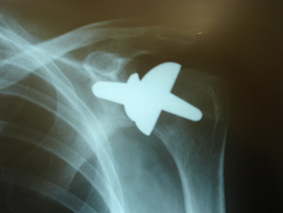What is arthritis? All bony surfaces in joints are covered with articular cartilage. Articular cartilage has a very smooth surface allowing the two bones meeting to form the joint to glide against each other. Arthritis is the wearing down of this articular cartilage. This starts by the cartilage becoming soft, then irregular and eventually disappearing completely to expose the underlying bone.
What causes shoulder arthritis?
In general, there are several different types of arthritis. Osteoarthritis, the most common cause of arthritis, affects people in their seventies and eighties. Rheumatoid arthritis may affect the shoulder, but would normally start in the hand. Post-traumatic arthritis affects the shoulder following a fracture of the ball or socket of the shoulder joint. Arthritis can develop as a result of a longstanding large rotator cuff tear, called rotator cuff arthropathy. Arthritis may also develop following longstanding instability of the shoulder, instability arthropathy. Arthritis may develop after loss of the blood supply of the ball part of the joint, called avascular necrosis.
Are there any other joints around the shoulder that can become arthritic?
Arthritis may affect the acromioclavicular or sternoclavicular joint, discussed under AC Joint - Collarbone .
What does having arthritis feel like?
Arthritis is a painful condition, causing pain at night as well as with activity. The pain is normally associated with increasing loss of movement. Sometimes, grating is felt or even heard when trying to move the shoulder.
How can I find out if I have arthritis?
Your doctor will examine you and organise an X-ray to confirm that. Occasionally, a computerised tomography scan may be required to get more information, particularly if surgery is being considered.
What can be done about shoulder arthritis?
Treatment depends on the amount of pain and loss of function you are suffering as a result of the arthritis. If pain is not a major problem and you are willing to accept some loss of function, particularly if your health in general is not good, then physiotherapy to try and maintain your movement and improve your strength is all that is required.
If the pain is severe, but your health is not good, pain may be temporarily relieved by an injection into the joint. Unfortunately, with repeated injection the pain relief becomes less and less. Also, injections may lead to deterioration of the arthritis and carry a small risk of infection.
What are the other alternatives for treatment?
If pain is severe, and your health is good, you may have to consider surgery. The type of surgery suggested will depend on the stage of arthritis. If the arthritis is early and your movement is good, pain may be relieved by keyhole surgery to clean the products of arthritis from the joint and smoothen the irregularities in the articular cartilage.
If arthritis has already progressed and shoulder movement is becoming limited and painful, a joint replacement may be the only option available. A joint replacement aims to replace the articular cartilage covering the joint surface with a smooth metallic surface. This may involve replacing the articular surface on the ball side of the joint only, called a shoulder hemiarthroplasty. The other alternative is to replace the articular surface on both the ball and the socket sides of the joint, called a total shoulder replacement.
Which operation and what type of joint replacement is more appropriate for you will depend on the stage of the arthritis, the cause of the arthritis and the state of the muscles surrounding the shoulder joint. This will need discussion with your surgeon before a final decision can be made.
What about surface replacement of the shoulder?
In general, when feasible (over 90% of the time), the ball of the joint is replaced using a surface replacement. This involves replacing the damaged surface only and not removing the top of the arm bone as with a traditional joint replacement. This allows more accurate positioning of the joint replacement. It also reduces the amount of bone removed, which is very helpful on the rare occasions when further surgery is required.



What does a joint replacement mean for me?
The operation will be done under a general anaesthetic using an incision at the front of the shoulder. It will mean being in hospital for 3-5 days. Exercises will be guided by the physiotherapist, starting the day after the operation. For the first 3 weeks, when you are not doing the exercises, the arm will be rested in a sling. Driving is possible between 4 and 6 weeks after the operation. Lifting light objects can begin at 3 weeks, but heavy lifting is not recommended for 3 months. Return to a desk type job is possible at 6 weeks, but heavy manual work is not recommended after this operation.
The main aim of this operation is to relief pain and this happens over 85% of the time. Movement, function and strength of the shoulder improve, but are not completely normal. This improvement in function is dependant on the state of the muscles around the shoulder and will continue for 18 months after the operation.
Back to top